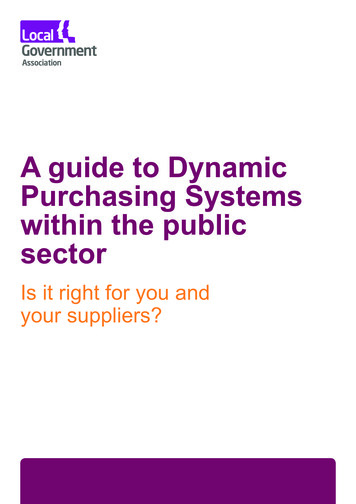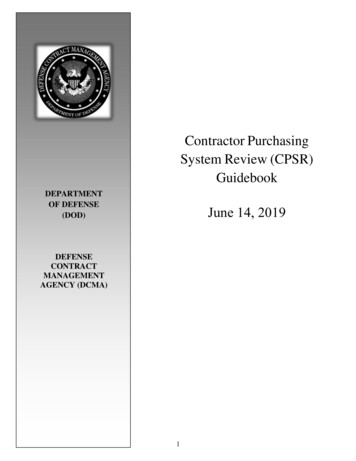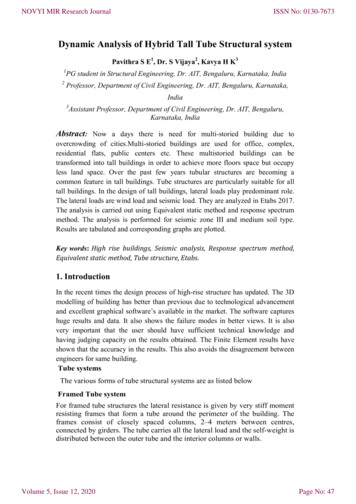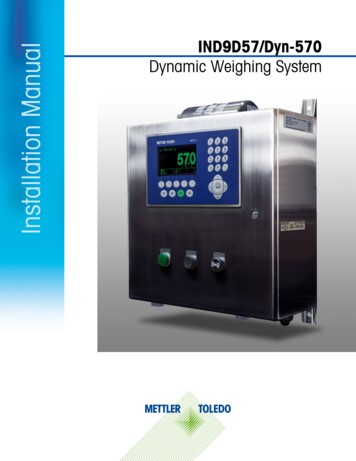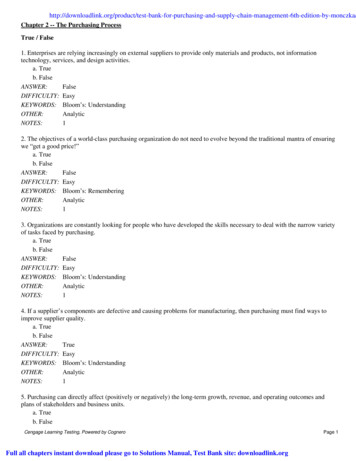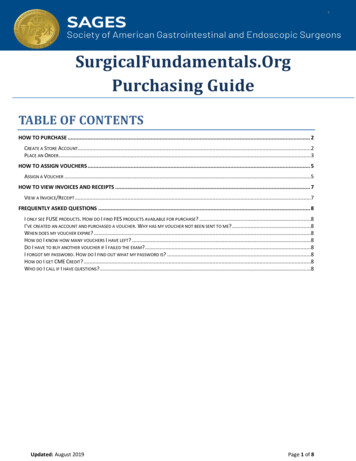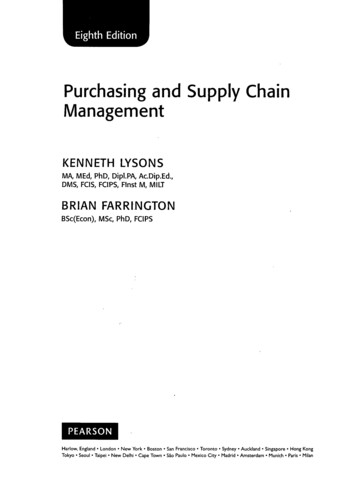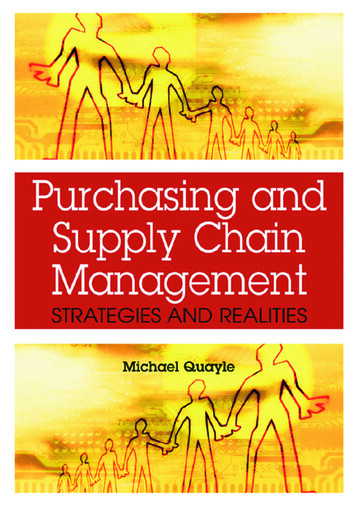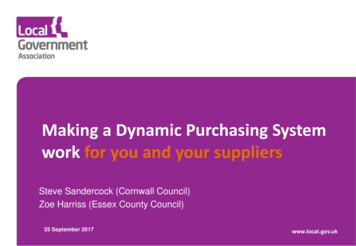
Transcription
Making a Dynamic Purchasing Systemwork for you and your suppliersSteve Sandercock (Cornwall Council)Zoe Harriss (Essex County Council)25 September 2017www.local.gov.uk
Introduction and Aims of the session The work undertaken with the Local GovernmentAssociation on DPS. Outline the concept on what a DPS is. When they are best suited to be used. Findings from the research on DPS arrangements,including:The benefits and challenges to overcome &tips for successwww.local.gov.uk
Concept on what a DPS is Public Sector procurement has for a long time had the option toutilise Dynamic Purchasing Systems (DPS) as route to market as aviable alternative to frameworks Unlike the use of frameworks the understanding and use of DPSappeared less well known Details set out in Regulation 34 of the Public ContractsRegulations 2015www.local.gov.uk
Key characteristics – what differsfrom a Framework Open for suppliers to join at any time, subject to qualification stage. Suppliers able to reapply if not successful in first application. It has to be an all electronically process – both from the applying to be on it toplacing of opportunities through it. Increases transparency for suppliers and Small Medium Enterprises (SMEs) andnew entrants to the marketplace. Creates active competition in real time. No time limit in duration for a DPS (frameworks limited to 4 years)
When to use a DPS?As part of wider discussions across a group of Public Sector partners there wasinterest around wanting to find out more in how best to maximise the benefits fromDPS and minimise any downsides.Virtual group of public sector partners and Local Government Association set up toexplore this further, with the aim of: Creating a forum to share ideas and learning on DPS – remove myths aroundimplementing DPS; Generating guidance, tools and tips for other Local Government and Public Sectorin the practical application of DPS as a credible option for doing things differently; Developing and sharing case study learning, and areas of best practice orexcellence.
When to use a DPS?Overall aim to aid and advance investment decisions in a manner which maximisesopportunities to exploit DPS as means of engaging with relevant market sectors.
Some key characteristics for whenDPS is suitable useKey characteristics of what might make consideration of a setting up a DPS a suitable delivery option – courtesy of Essex County Council‘Making the Case to Implement a Dynamic Purchasing System’, December 2016.
This is further explored and interpreted as part of the LGAGuidance into a checklist looking at ents/Appendix%203%20-%20DPS%20checklist.pdf
But you do have to understand themarket “DPS seems to work well where there is avibrant, competitive market however in socialcare the issues are often around creating amarket, for example social care in remote areasis an issue, foster care is scarce”Quote from Procurement professional as part of Survey response
What of the findings?Desktop research – reviewing Contract Notices in OJEU highlighted: 4 main areas where DPS is being used, Social care 72 million Passenger Transport (inc. home to school transport) 93 million Training 38 million Construction 79 million Quite a few diverse areas where DPS had been used, in smaller or singularnumbers (e.g. advertising, car parking, cleaning, enforcement, food, legal services,leisure, packaging, photography etc.). DPS Systems, 15 system suppliers, but dominated by 4 / 5 suppliers.
“The Survey Say ” Findings from survey across public sectorpartners further supported this;
The BenefitsTop reasons for implementing DPS by Public Sector organisations surveyed were: Improved flexibility for suppliers Stimulating the market Cost savings through increase competition, closely followed by Potential to increase access to arrangements by SMEs and improved processes.From the survey undertaken of Suppliers themselves with top benefits they considered being: Increased access work opportunities with the public sector. Making it easier to do business with the Public Sector Plus crucially the ability to reapply if unsuccessful in initial qualification stage.
Balance of benefit as seen by suppliers Don’t forget to engage with the suppliers along the journey, ensuring they are adequatelysupported during both implementation and delivery.
The view of the Federation of SmallBusiness (August 2017)One of the five recommendationswithin their report “Replace framework agreementswith Dynamic Purchasing Systems(DPS), where possible, so smallbusinesses are not locked out fromlists of potential suppliers to localauthorities”.“ .many FSB members have indicated that they therefore prefer to work with DPS,which they regard as a small business friendly alternative to frameworks”.
The challenges or downsides being:One of the main barriers identified as to whetheror not to implement a DPS indicate a lack ofunderstanding of what a DPS is.
Experience from those who hadimplemented DPS arrangements Tracking and measuring of Benefits not currently done - and this can be a big gap(especially around qualitative benefits). This can lead to difficulties in gaining overallstakeholder sign up to using or advancing use of DPS within an organisation. Frontend administration can be “heavy” in setting up a DPS, it is important not tounderestimate the resource needed to support the business / client side to get this up andrunning as business as usual. For example for Cornwall Council was the setting up of over130 taxi providers at the start of the DPS (e.g. first couple of months) now more manageablenumbers (4 / 5 per month). The need to gain support from internal stakeholders – it can be a struggle to “sell thebenefits” especially without clearly demonstrable benefits being available from real examples. Need to support the supply base to get them onto the system (certainly in areas wheretechnology / tendering is not common place means of transacting)
Tips to successful implementation Speak to others who have set up or operate a DPS. Engage with key stakeholders. Don’t underestimate the potential challenge around cultural change. A robust business case formally signed off is considered a must – as well as measuringoutcomes against the intended benefits outlined in the business case. Consider running a pilot – trial it before rolling out a DPS across a range of categories. Properly resource it – both implementing and also during delivery. Surveying and understanding suppliers to find out how things are going and how things canbe improved (e.g. 6 month survey) can be beneficial. Don’t forget to engage with the suppliers along the journey, ensuring they are adequatelysupported during both implementation and delivery.
Bringing your suppliers on the journey The survey of suppliers who are (or have been) part ofsupplying services through a DPS arrangement providedvaluable insight about how to get the best results.
Other useful informationA guide to Dynamic Purchasing Systems within the public sector - Is it right for you and your suppliers? ents/4%2030%20DPS%20Guidance 04 Web.pdfSupporting appendices to the guidance (including the survey results and checklist) tegy/modernising-procurementPublic Contract Regulations – Regulation 34 tion/34/madeFederation of Small Business Report - Unstacking the deck: balancing the public procurement odds -uk/procurement-report-final.pdf?sfvrsn 0
Thank you for your time and any questionsSteve Sandercock (Cornwall Council)Email: m/in/steve-sandercock581717107/Zoe Harriss (Essex County Council)Email: zoe.harriss@essex.gov.uk
The Benefits. Top reasons for implementing DPS by Public Sector organisations surveyed were: Improved flexibility for suppliers Stimulating the market Cost savings through increase competition, closely followed by Potential to increase access to arrangements by SMEs and improved processes.
